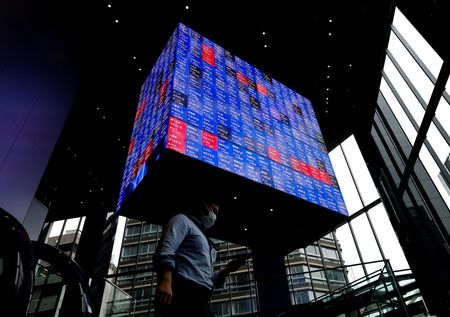
By Wayne Cole
SYDNEY (Reuters) – Asian shares edged higher on Monday as investors waited nervously to see whether the Bank of Japan (BOJ) would defend its super-sized stimulus policy at a pivotal meeting this week, while a holiday in U.S. markets made for thin trading.
There were rumours the BOJ might hold an emergency meeting on Monday as it struggles to defend its new yield ceiling in the face of massive selling.
That had markets in an anxious mood, and Japan’s Nikkei slipped 1.0% to a two-week low.
MSCI’s broadest index of Asia-Pacific shares outside Japan still edged up 0.5%, with hopes for a speedy Chinese reopening giving it a gain of 4.2% last week. China’s blue chip index was also up 0.6%.
EUROSTOXX 50 futures added 0.6%, while FTSE futures put on 0.1%. S&P 500 futures and Nasdaq futures were flat, after a Wall Street bounce last week.
Earnings season gathers steam this week with Goldman Sachs, Morgan Stanley and the first big tech name, Netflix, among those reporting.
World leaders, policy makers and top corporate chiefs will be attending the World Economic Forum in Davos, and there are a host of central bankers speaking, including no fewer than nine members of the U.S. Federal Reserve.
The BOJ’s official two-day meeting ends Wednesday and speculation is rife it will make changes to its yield curve control (YCC) policy given the market has pushed 10-year yields above its new ceiling of 0.5%.
The BOJ bought almost 5 trillion yen ($39.12 billion) of bonds on Friday in its largest daily operation on record, yet yields still ended the session up at 0.51%.
Early Monday, the bank offered to buy another 1.3 trillion yen of JGBs, but the yield stuck at 0.51%.
“There is still some possibility that market pressure will force the BOJ to further adjust or exit the YCC,” JPMorgan analysts said in a note. “We can’t ignore this possibility, but at this stage we do not consider it a main scenario.”
“Although domestic demand has started to recover and inflation continues to rise, the economy is not heating up to the extent that a sharp rise in interest rates and potential risk of large yen appreciation can be tolerated,” they added. “Thus, we think the economic environment does not strongly support consecutive policy changes.”
THE YEN UN-ANCHORED
The BOJ’s uber-easy policy has acted as a sort of anchor for yields globally, while dragging down on the yen. Were it to abandon the policy, it would put upward pressure on yields across developed markets and most likely see the yen surge.
The dollar is already at its lowest since May at 127.67 yen, having shed 3.2% last week, and threatens to break major support around 126.37.
The euro also lost 1.5% on the yen last week, but was aided by gains on a broadly softer dollar, which saw it stand at $1.0826 on Monday, just off a nine-month peak.
All of which saw the U.S. dollar index ease to its lowest since June at 101.98.
The dollar has been undermined by falling U.S. bond yields as market wagers the Federal Reserve can be less aggressive in raising rates given inflation has clearly turned the corner.
Futures now imply almost no chance the Fed will raise rates by half a point in February, with a quarter-point move seen as a 94% probability.
Yields on 10-year Treasuries are down at 3.51%, having fallen 6 basis points last week, close to its December trough, and major chart target of 3.402%.
Alan Ruskin, global head of G10 FX Strategy at Deutsche Securities, said the loosening of global supply bottlenecks in recent months was proving to be a disinflationary shock, which increases the chance of a soft landing for the U.S. economy.
“The lower inflation itself encourages a soft landing through real wage gains, by allowing the Fed to more readily pause and encouraging a better behaved bond market, with favourable spillovers to financial conditions,” Ruskin said.
“A soft landing also reduces the tail risk of much higher U.S. rates, and this reduced risk premia helps global risk appetite,” Ruskin added.
The drop in yields and the dollar has benefited gold, which jumped 2.9% last week to the highest since April and was last trading at $1,920 an ounce. [GOL/]
Oil prices also rallied last week on hopes the speedy reopening of China would boost demand. Data on mobility, traffic and transport trips in China have shown a sharp revival in movement ahead of the Lunar New Year holidays next week. [O/R]
Chinese data on economic growth, retail sales and industrial output due this week are certain to be dismal, but markets will likely look past that to a rapid recovery now coronavirus restrictions have been dropped.
Prices eased back a touch on Monday, with Brent off 31 cents at $84.97 a barrel, while U.S. crude fell 27 cents to $79.59.
($1 = 127.8000 yen)
(Reporting by Wayne Cole; Editing by Shri Navaratnam)

